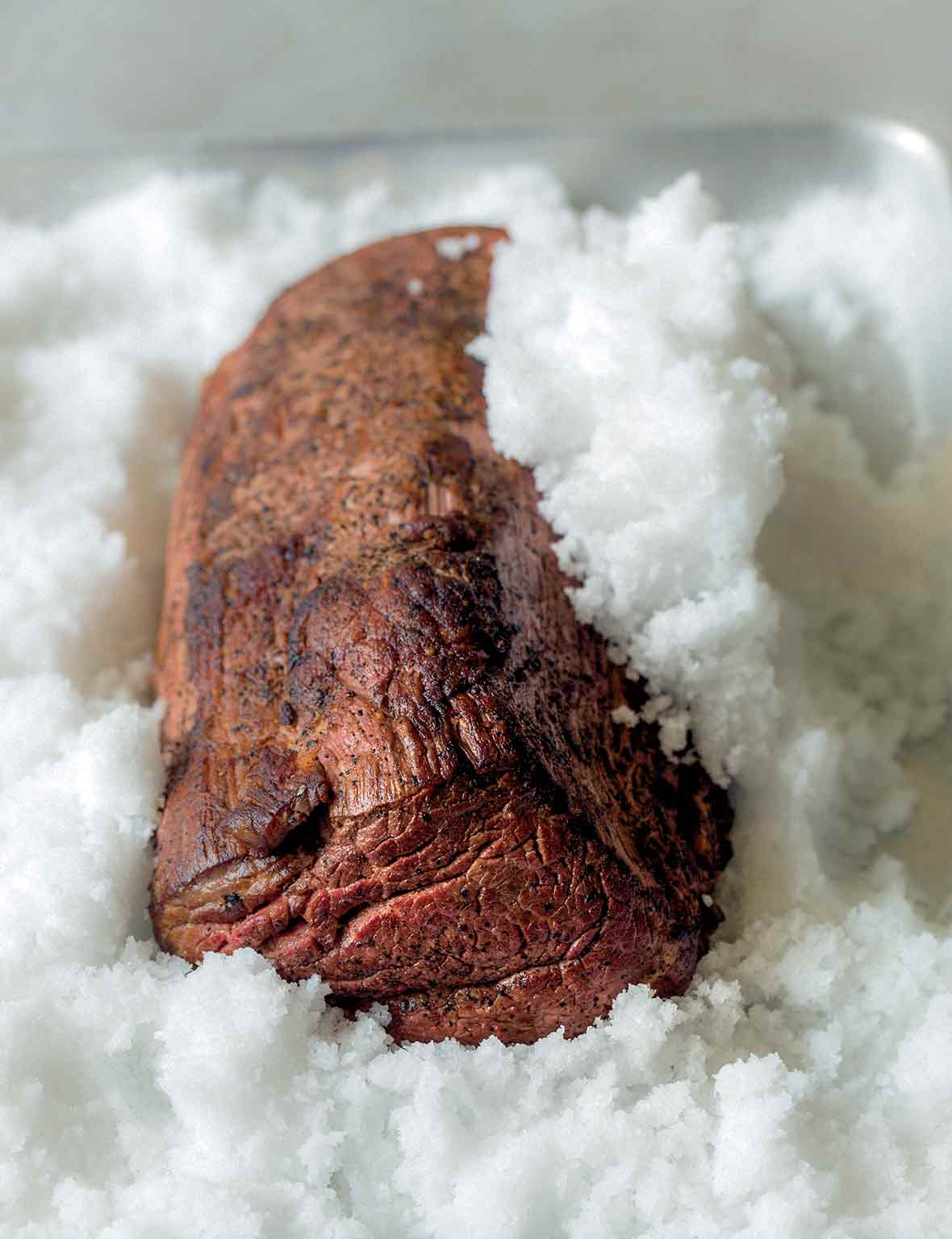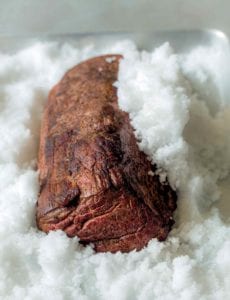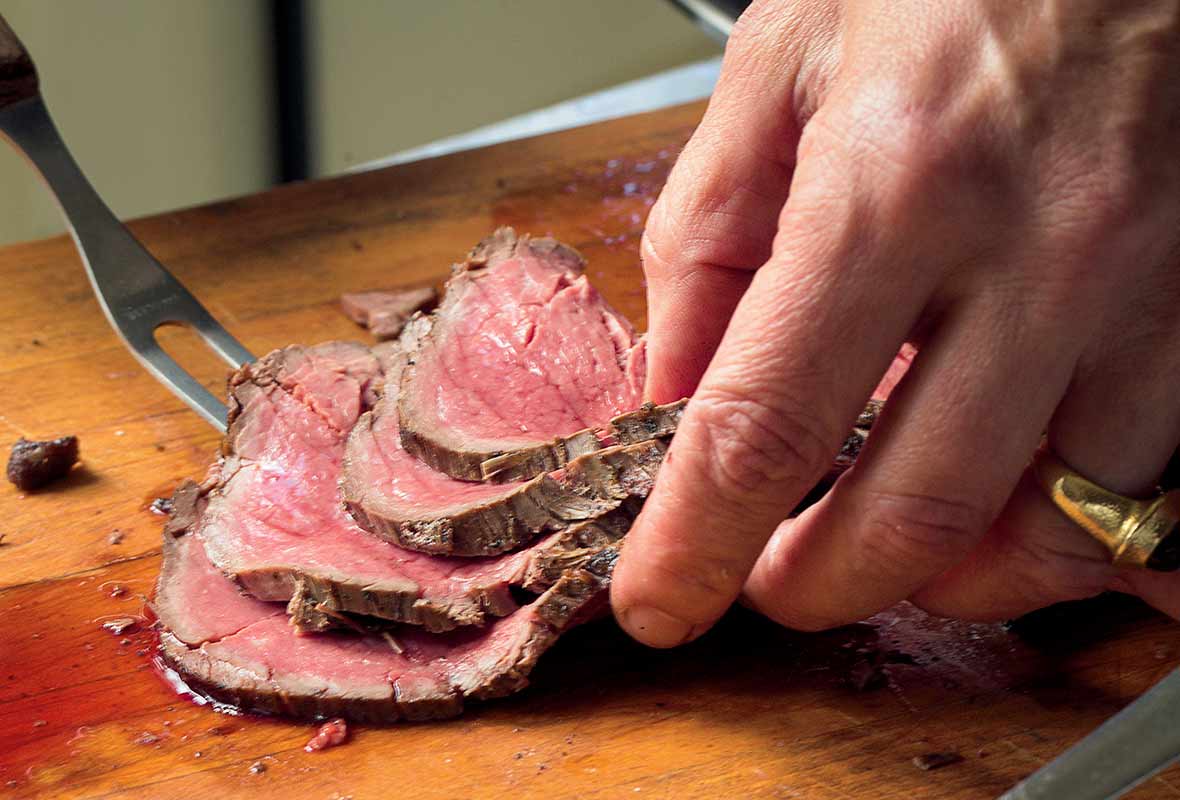
Brilliant. That’s what we think of this salt-crusted beef tenderloin recipe from chef Gabrielle Hamilton of Prune in New York City’s East Village. It’s brilliance lies in the fact that the insanely flavorful juices are trapped within the roast during cooking. They simply can’t leak out, ensuring that pricey cut of beef will be lovely and perfectly cooked to a medium-rare. There’s also some brilliance to the fact that it’s ridiculously easy to achieve and makes for a conversation-stopping moment if guests are in the kitchen when you pull it out of the oven. The optional bread crumb salsa accompaniment lends a lovely acidity to the rich roast, although trust us, that’s not requisite to the appreciation of this roast tenderloin.–Renee Schettler Rossi
LC What Folks Are Saying About This Recipe Note
“The most succulent roast I’ve had in a long time.” “Everyone should try this cooking method.” “Astonishing.” “Perfectly beefy.” “I am at a loss for words.” That’s what folks are saying about this salt-crusted beef tenderloin recipe.

Salt-Crusted Beef Tenderloin
Ingredients
For the salt-crusted beef tenderloin
- 24 ounces beef tenderloin, trimmed
- 1 tablespoon grapeseed oil
- 2 teaspoons finely and freshly ground black pepper
- 2 pounds kosher salt*, preferably Diamond Crystal
- 1 1/4 to 1 1/2 cups cold water
- 1 large egg, (optional)
For the bread crumb salsa (optional)
- 1 cup extra-virgin olive oil
- 6 ounces artisan-style bread, day old and torn into free-form small-ish “croutons”
- 2 lemons (preferably organic), zested
- 1 pound assorted sweet cherry tomatoes, split in half
- 1 bunch scallions, sliced thinly in rings, from the white all the way up through as much of the green stalk as is edible
- 4 small cloves fresh and sticky new garlic, thinly sliced
- 1 packed tablespoon plus 1 packed teaspoon salt-packed anchovies, rinsed, filleted, and then minced
- 2 tablespoons red wine vinegar
- 1/2 cup clean, dry, flat-leaf parsley leaves
- Sea salt and freshly ground black pepper
Instructions
Make the roast beef
- Preheat the oven to 250°F (121°C). Place a wire rack on a rimmed baking sheet. Heat a large, heavy, cast-iron skillet or Dutch oven over medium heat for 5 minutes. Yep, 5 minutes. Make certain the heat is on medium and no higher. Also make certain your hood fan is on.
- Using your hands, rub the grapeseed oil over the beef to coat all sides and then sprinkle it evenly with black pepper. Brown the beef tenderloin, using tongs to turn it as necessary so it gets thoroughly browned on every side, including the ends. You want the meat to have a nice crust all around to create a barrier for the salt crust. It’ll take at least 7 to 8 minutes to get a good sear. Transfer the tenderloin to the wire rack to cool.
- In a bowl, mix the salt with some of the water to form what looks like bright white wet sand. Start with 1 1/4 cups water and, if necessary, add more water, a little at a time, to achieve a sand-like consistency that sticks to itself when you squeeze it in your hand. (If you’re having a tricky time with the salt mixture adhering to itself, dump it back in the bowl, add an egg white, mix well, and try again.)
- When the tenderloin is cool and mostly dry, spread a thin but solid and even layer of salt on the bottom of a small rimmed baking sheet or a smallish roasting pan with low sides. Place the tenderloin on the salt. Pack the remaining salt tightly and tidily around the tenderloin to create a solid coating, sorta like a cast on a broken leg. Where there are cracks in the crust, redistribute the salt to patch them. This should be an unfussy task! There is no such thing as perfect. (If you use a cut of meat that’s larger than 1 1/2 pounds, you’ll need more salt and water to encase it. Mix up a little more of the salt mixture so the beef is completely surrounded by salt.)
- If you have an oven-safe instant thermometer, insert it through the salt into the beef. Place the salt-crusted beef and its pan in the oven and roast for 45 minutes. If the beef is the exact weight specified in this recipe, then 45 minutes at 250°F (121°C) will deliver medium-rare tenderloin. Otherwise, insert an instant thermometer straight into one of the short ends of the tenderloin directly into its center. The beef is ready to take out of the oven when it hits 125°F (52°C) in its center.
Make the bread crumb salsa (optional)
- While the tenderloin is in the oven, place a small, deep-sided sauté pan over medium-high heat. The oil should be just deep enough to submerge the first tip of your index finger. Heat the oil. (Good olive oil is rarely recommended for frying. But the author really prefers the flavor it adds.) Have ready a stack of basket-style coffee filters or a brown paper bag next to the stovetop.
- When the oil makes beautiful, veinous, streaking patterns in the pan, which will move faster as the oil gets hotter, drop in a crouton as a test. If it sizzles on contact, the oil is ready. Keep a careful watch on the oil, turning the temperature down as needed, as you do not want the oil to smoke.
- Fry the croutons until golden brown. Using a slotted spoon, drain them on the coffee filters or brown paper bag. Let the oil cool.
- While the oil cools, supreme the lemons. (See the video on how to supreme citrus just above the recipe.) Simply slice off both ends of each lemon to reveal some of the fruit beneath. Stand a lemon on one end. Starting at the top of the lemon, use the knife to slice away the peel and underlying white pith, following the curve of the fruit, and repeat, turning the lemon as needed, until all the peel and pith is removed. Hold the lemon over a bowl in one hand and, using the other hand, slide the knife blade alongside a membrane and then alongside the other membrane of that same segment, slicing all the way through to the center of the lemon. The lemon segment should fall away into the bowl without any stringy membrane attached. Repeat with the remaining segments, letting any juice drip into the bowl beneath. When you’re done, squeeze the membranes to release any more juice and then toss the membranes in the compost. Repeat with the second lemon.
- To the lemons and their juice add the zest, tomatoes, scallions, garlic, anchovies, and vinegar and toss well. Add the fried croutons and 1/3 cup of the cooled frying oil.
- Rub the parsley leaves between your hands to release the grassy aroma and then toss them in the salsa. Sparingly season the salsa with salt and pepper to taste, keeping in mind that the beef will bring some saltiness to the plate.
Assemble the dish
- Using a mallet or a wooden spoon, crack the salt crust on the tenderloin, dust away the granules of salt clinging to the beef with a clean, dry towel, and place the beef on a cutting board.
- Slice the tenderloin, aiming for portions of 6 ounces. Arrange the slices on each plate, overlapping the slices slightly. If using the salsa, drizzle a generous spoonful of salsa over the meat, being careful to let the perfect wall-to-wall pink of the filet show through. If you wish, drizzle the beef with some of the remaining fry oil to finish. Do not season further. Serve immediately.
Notes
*Kosher Salt Note
Different brands tend to have different size crystals, so the weight and volume of salt will vary from one brand to the next. Chef Gabrielle Hamilton uses Diamond Crystal, but feel free to use whatever brand of kosher salt you have on hand. Just know that you might need a little more or a little less than precisely 2 pounds, depending on the size of the salt crystals.Explore More with AI
Nutrition
Nutrition information is automatically calculated, so should only be used as an approximation.
Recipe Testers’ Reviews
I am at a loss for words to describe this salt-crusted beef tenderloin. At first I thought this would be an instant heart attack, but it turned out to be the most succulent roast I’ve had in a long time. This is a very easy recipe to make. Everyone should try this cooking method. The results are astonishing.
As far as all that salt goes, you don’t even know it was ever on the beef. The flavor of the meat shines through as well as all the delicious juices that usually drip out during cooking. Attribute that to the sear. It’s important that the meat has a good crust. You really need to have a hood that vents outside or you will be setting off smoke alarms for sure. I used olive oil instead of some grapeseed oil and browned the beef in a cast-iron Dutch oven so I could place the splatter screen on top.
I used canned anchovies in olive oil because that’s all I could find and drained and rinsed them for the salsa. I used some leftover French baguette for the croutons, just tearing it into pieces, frying as directed, and draining on paper towels.
My meat was just about 2 pounds, so I gave it an additional 5 minutes and it was done perfectly.
It says 6 servings but 3 of us devoured it with just enough left for a sandwich for lunch and some salsa as a salad replacement. Will likely be doing this often. I’m gonna try this with other cuts of meat as well. I highly recommend this one for sure.
I love baking in a salt crust. Everything I’ve tried comes out moist and perfectly seasoned. So as you can imagine, when this recipe came across my inbox, there was a resounding “yes! yes! yes!”
However, truth be told, I hacked the recipe a bit. After shopping around for beef tenderloin and thinking about the premise of the recipe (baked in salt) I had a hunch that other, less costly meats could stand in. So with fingers crossed, I set out to make an eye-round roast. I was able to find a small roast weighing just over 1 1/2 pounds and asked the butcher to tie-wrap a layer of fat around the meat. With all else being the same, I stuck my temperature probe into the browned meat, encased it in salt, and said a little prayer to the dinner gods. Unlike the tenderloin, the eye-round took about 20 minutes longer to reach 125°F for a total roast time of just over 1 hour.
Once removed from the oven and freed from its salt dome, I placed the roast on a piece of foil on the counter to catch any extra wayward salt and juices. I continued the recipe as described and set out to make the bread crumb salsa while letting the meat rest.
About 20 minutes later, the salsa was ready, and it was time for the moment of truth. How did the eye-round work out? Splendid! Delicious! And perfectly beefy for the acidic bread salsa. Not only do I now have the original tenderloin recipe for special occasions, but I have a nice weekend dinner project my crew can enjoy more regularly.
If you use a thermometer that you can encase in the roast, you will always know when to take it out of the oven by peeking at the exposed dial now and again.












I do this with whole Sockeye Salmon. Insanely good, and now I’m fairly certain that salsa will be made to elevate my dish to the gods!
Ani, I agree! Watch as the heavens open.
It looks like you cooked ET!
Oh dear. That’s not what we ever thought when we saw that photo, Michelle!